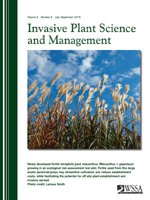Nonnative, invasive plants are becoming increasingly widespread and abundant throughout the southwestern United States, leading to altered fire regimes and negative effects on native plant communities. Models of potential invasion are pertinent tools for informing regional management. However, most modeling studies have relied on occurrence data, which predict the potential for nonnative establishment only and can overestimate potential risk. We compiled locations of presence and high abundance for two problematic, invasive plants across the southwestern United States: red brome (Bromus rubens L.) and African mustard (Brassica tournefortii Gouan). Using an ensemble of five climate projections and two types of distribution model (MaxEnt and Bioclim), we modeled current and future climatic suitability for establishment of both species. We also used point locations of abundant infestations to model current and future climatic suitability for abundance (i.e., impact niche) of both species. Because interpretations of future ensemble models depend on the threshold used to delineate climatically suitable from unsuitable areas, we applied a low threshold (1 model of 10) and a high threshold (6 or more models of 10). Using the more-conservative high threshold, suitability for Bromus rubens presence expands by 12%, but high abundance contracts by 42%, whereas suitability for Brassica tournefortii presence and high abundance contract by 34% and 56%, respectively. Based on the low threshold (worst-case scenario), suitability for Bromus rubens presence and high abundance are projected to expand by 65% and 64%, respectively, whereas suitability for Brassica tournefortii presence and high abundance expand by 29% and 28%, respectively. The difference between results obtained from the high and low thresholds is indicative of the variability in climate models for this region but can serve as indicators of best- and worst-case scenarios.
Nomenclature: Red brome, Bromus rubens L.; African mustard, Brassica tournefortii Gouan.
Management Implications: In the arid and semiarid regions of the southwestern United States, two nonnative, invasive plant species, red brome (Bromus rubens L.) and African mustard (Brassica tournefortii Gouan) occur at varying levels of abundance. Within the study region (i.e., the area from which presence and high abundance data were collected), bioclimate envelope models (BEMs) indicate current widespread climatic suitability for the presence of both species. However, central and northwest Arizona, southern Nevada, and Baja California, Mexico, are currently most climatically suitable for high abundance of Bromus rubens. Hot, dry regions of southern California are currently most climatically suitable for high abundance of Brassica tournefortii. Based on a high threshold (6 or more of 10 models project suitability), climatic suitability is projected to increase only for Bromus rubens presence ( 12%), whereas climatic suitability for Brassica tournefortii presence could decrease (−34%). Similarly, climatic suitability for high abundance of Bromus rubens (−42%) and Brassica tournefortii (−56%) could also decrease. For Brassica tournefortii, areas of contraction (i.e., projected loss of climatic suitability) appear in southern Arizona and California, and in Baja California and Sonora, Mexico. For high abundance of Bromus rubens, contraction is projected to occur along the southern edges of climatically suitable area, primarily in Arizona and Nevada. Climatic suitability for Brassica tournefortii is projected to contract mainly in western Nevada, southeastern California, and Baja California, Mexico. Based on an ensemble of future models and a low threshold (any 1 of 10 models projects suitability), climatic suitability





